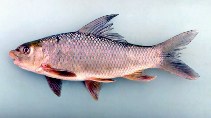| Family: |
Cyprinidae (Minnows or carps), subfamily: Labeoninae |
| Max. size: |
60 cm TL (male/unsexed) |
| Environment: |
benthopelagic; freshwater, potamodromous |
| Distribution: |
Asia: Mekong basin (Ref. 12693). Reported from Chao Phraya and Maeklong basins (Ref. 26336). |
| Diagnosis: |
Dorsal soft rays (total): 12-13. Presence of a deep transverse groove across top of snout; 12-13 branched dorsal-fin rays (10-11 in all other species of Bangana from the Mekong) (Ref. 12693). |
| Biology: |
Occurs in upland reaches of the Mekong. Inhabits rocky stretches of the main stem of Mekong during the dry season and moves into tributary streams during high waters (Ref. 12693). Found in riffle and slow deep reaches (Ref. 37769). Herbivorous, feeding on algae, phytoplankton and periphyton. Not known to persist in impoundments (Ref. 12693). At Stung Treng below the Khone Falls, the species migrates upstream at the start of the rainy season in May-June and downstream in the dry season from November to February. At Sambor and Kratie as well as just south of Khone Falls, it moves downstream at the onset of the rainy season and upstream in the dry season. The reason for such movement seems to be the presence of the important tributary system, Sekong-Sesan-Srepok rivers. Fishermen reported that this fish migrates from this system into the Mekong during receding water and migrates upstream the tributaries during the rainy season, possibly to spawn. Upstream the Khone Falls, this fish begins migrating upstream in the dry season (February-May) and continues into the beginning of the rainy season. This movement may, in fact, be two separate migrations: a dry season non-reproductive migration of smaller fish and an early rainy season migration of larger fish in spawning condition. Undertakes upstream migrations from Khone Falls all the way to Chiang Khong in northern Thailand which are triggered by the increase of water levels and the change in water-color from clear to red-brown. Migrates upstream in schools together with other cyprinids such as Labeo cf. pierrei, Cirrhinus microlepis, Labeo chrysophekadion and Cyclocheilichthys enoplos as well as the loach, Botia modesta (Ref. 37770). Marketed fresh (Ref. 12693). |
| IUCN Red List Status: |
Vulnerable (VU); Date assessed: 22 February 2011 (A2d+3c) Ref. (130435)
|
| Threat to humans: |
harmless |
Source and more info: www.fishbase.org. For personal, classroom, and other internal use only. Not for publication.

